These Apple Pie Filling Cinnamon Rolls from scratch start with a fluffy, easy homemade brioche dough. They then get packed with oodles of spiced apples, baked into a deliciously spiraled apple-filled bun, and finally, topped with a sweet and tangy cream cheese glaze for the ultimate breakfast treat mash-up!

Jump to (scroll for more!):
Two Classics are Better than One
Whether you're a cinnamon roll lover, or an apple pie lover, you've come to the right place.
To be honest, I haven't found a ton of TikTok trends that I needed in my life. But, when I heard about combining two of my favorite classics treats together into the delicious mash-up that is cinnamon rolls with apple pie filling, I decided this trend miiiight be on to something.
Of course, being the baker I am, I wanted to jazz the recipe up a bit with both homemade cinnamon roll brioche dough and homemade apple pie filling.
But don't worry - I made every component of these tasty rolls as easy as possible to make from scratch. And I promise, the baked apple cinnamon roll masterpiece that comes out the other side of this recipe, is well worth a little extra scratch baking.
When you bite into this soft and pillowy apple-filled roll, I think you'll agree that in this case, these two old school treats create one epic pastry that proves these two classics are definitely better together!

Kneading with a Bread Machine or Mixer
I know bread doughs can be scary, but I wanted this dough to be easy to make without any hand mixing required.
Brioche is really high in butter and has egg in it as well unlike traditional sandwich breads. This means it's delicious, but also that it can be a sticky mess to knead by hand. The dough stays extra tacky for a long time during mixing because all that fat takes a while to incorporate.
I wanted to make sure you didn't have to deal with that. So, I've developed this recipe to be mixed 100% on a stand mixer, or in a bread maker on the "manual" or "dough" cycle.
You'll then look for indicators like a "window pain" structure or the "bounce back" of the dough to know it's ready to move onto the next step.
If you don't know what any of that means - don't worry!
I'll provide all of the tutorial photos you need below so you know exactly what you're looking for.
Ingredient Tips for Better Baking
(Pssst…if you're ready to just get baking, get all the details in the recipe card below!)
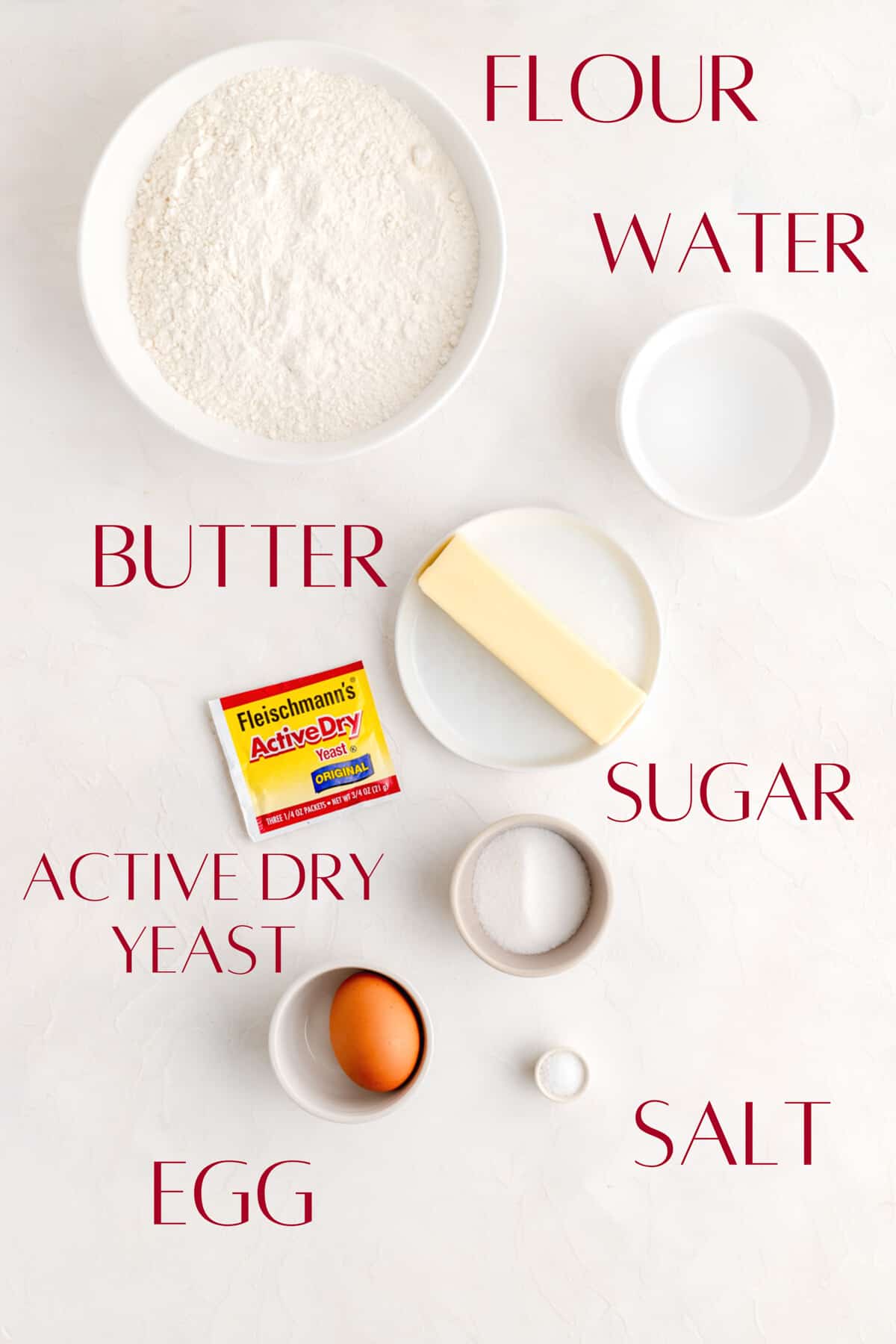



- Lukewarm water: the best way to ensure the right temp of water is to use an instant-read thermometer (we’re going for 75-80°F here). But if you don’t have one available, just use your best judgement to feel when the water is “lukewarm,” but not “hot.” If the water is too hot or too cold, it will negatively effect the yeast and your dough's rise.
- Active dry yeast, not instant/rapid! For this recipe we want to use “active dry yeast” because it’s designed for the 2-rise process we’re using here. If you have the bulk bags of yeast, you can use Red yeast or the Gold yeast (which is designed to be used with enriched doughs like this one). Rapid/Instant yeast is what we don't want to use. It is only designed to rise once, and likely will lead to a less risen, and less flavorful roll.
- Butter: we're using a lot of butter in this recipe to keep this dough nice and tender so make sure it's unsalted. The butter also needs to be very soft to incorporate properly into the dough, so make sure you take it out for the fridge at least 3-4 hours (or ideally overnight) before adding it to your dough.
- Apples: the type of apple you use isn’t too important here as it’s okay if they break down a bit in the filling. So I’d use whatever apple you enjoy the flavor of the most, leaning a little on the tart side to balance the sweetness in the filling. I like Braeburn and Honeycrisp apples, personally.

Special Tools You'll Need
For making the dough you'll need either a stand mixer fitted with a dough hook or a bread machine. You'll also need a rolling pin for assembling the rolls.
How to Make Apple Pie Cinnamon Rolls from Scratch
(Pssst…if you're ready to just get baking, get all the details in the recipe card below!)
*Prep note: while there is technically time to make the filling during the first rise of the dough, you'll find that doesn't usually give you enough time to cool the filling. A hot filling will seriously damage your dough and make your rolls very difficult to handle, in addition to preventing a proper rise. As such, I strongly recommend making the filling before starting the dough. Even though it'll add a bit of time, this will ensure the filling is plenty cool by the time you're assembling your rolls.
TO MAKE THE FILLING:
- Stir together all the dry ingredients for the filling.

- Melt the filling butter in a medium saucepan.

- Add all other filling ingredients to the pan.

- Cook apples until tender, and coated with a thick caramel sauce. Cool apples in the freezer, stirring frequently, while preparing the dough.

TO MAKE THE DOUGH:
- Combine yeast and water, and let sit for 5 minutes to activate/start to dissolve.
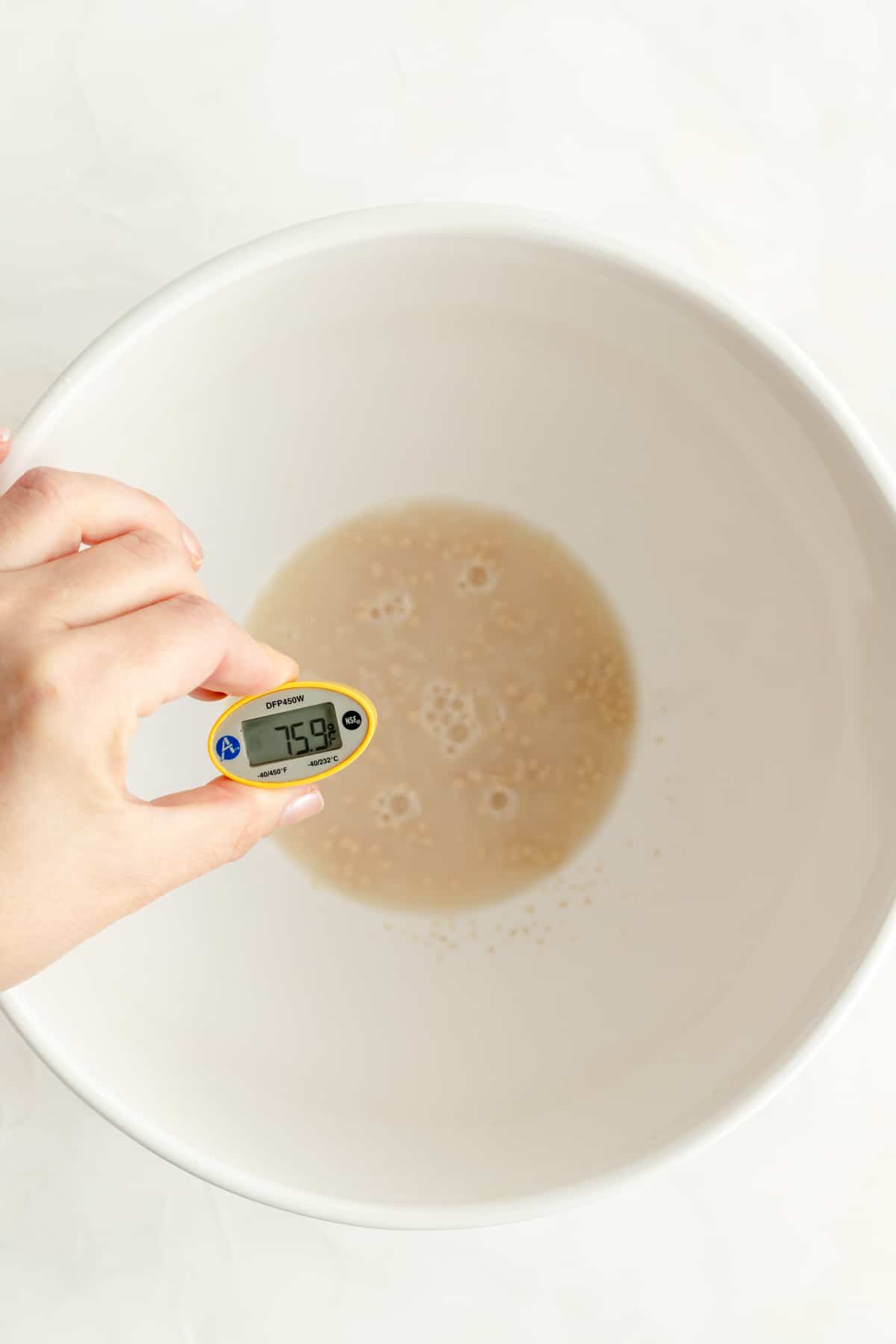
- Stir in the egg.

- Add dries and butter, then mix on low to combine.

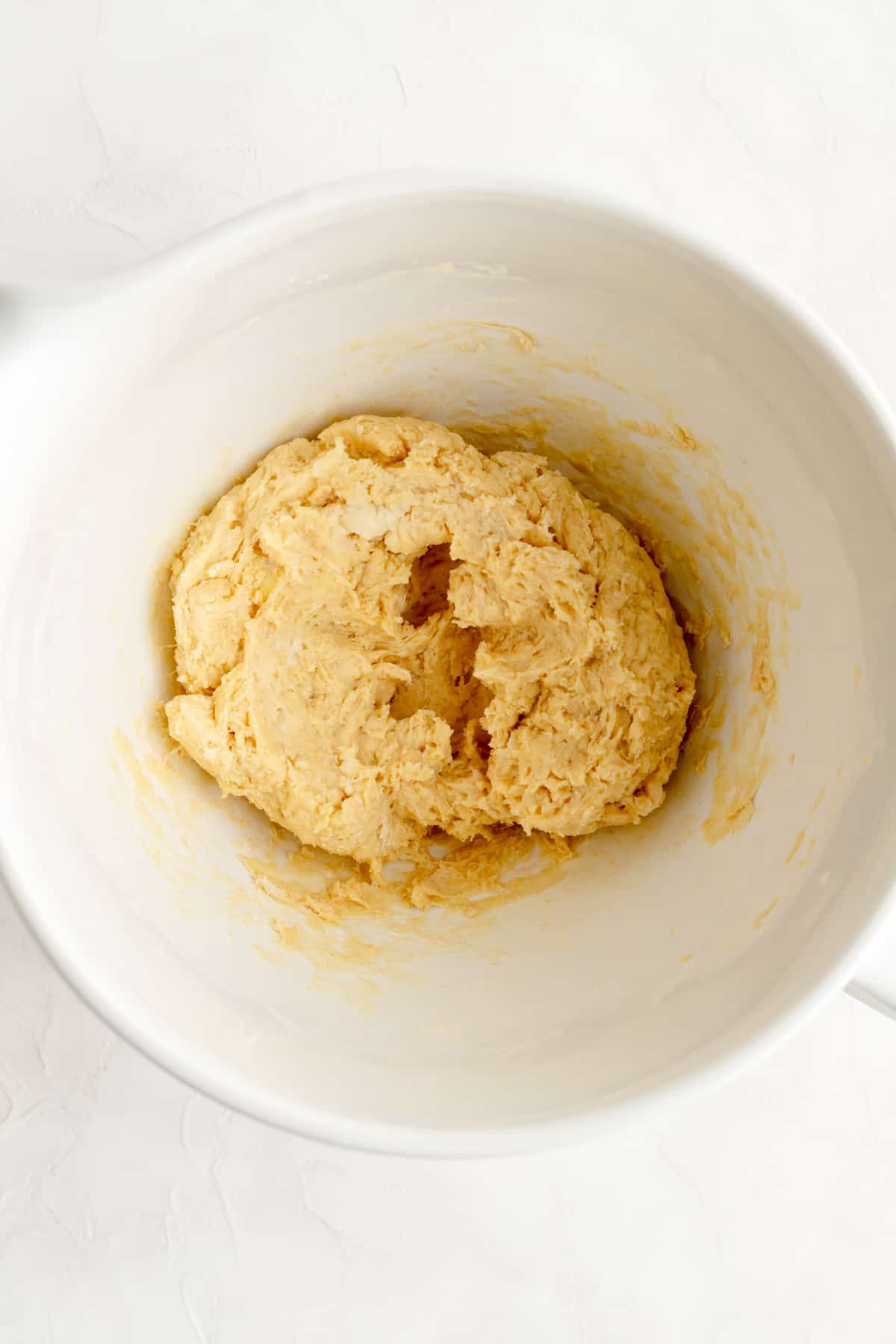
- “Knead” on medium-low speed until elastic, with a "window pane."


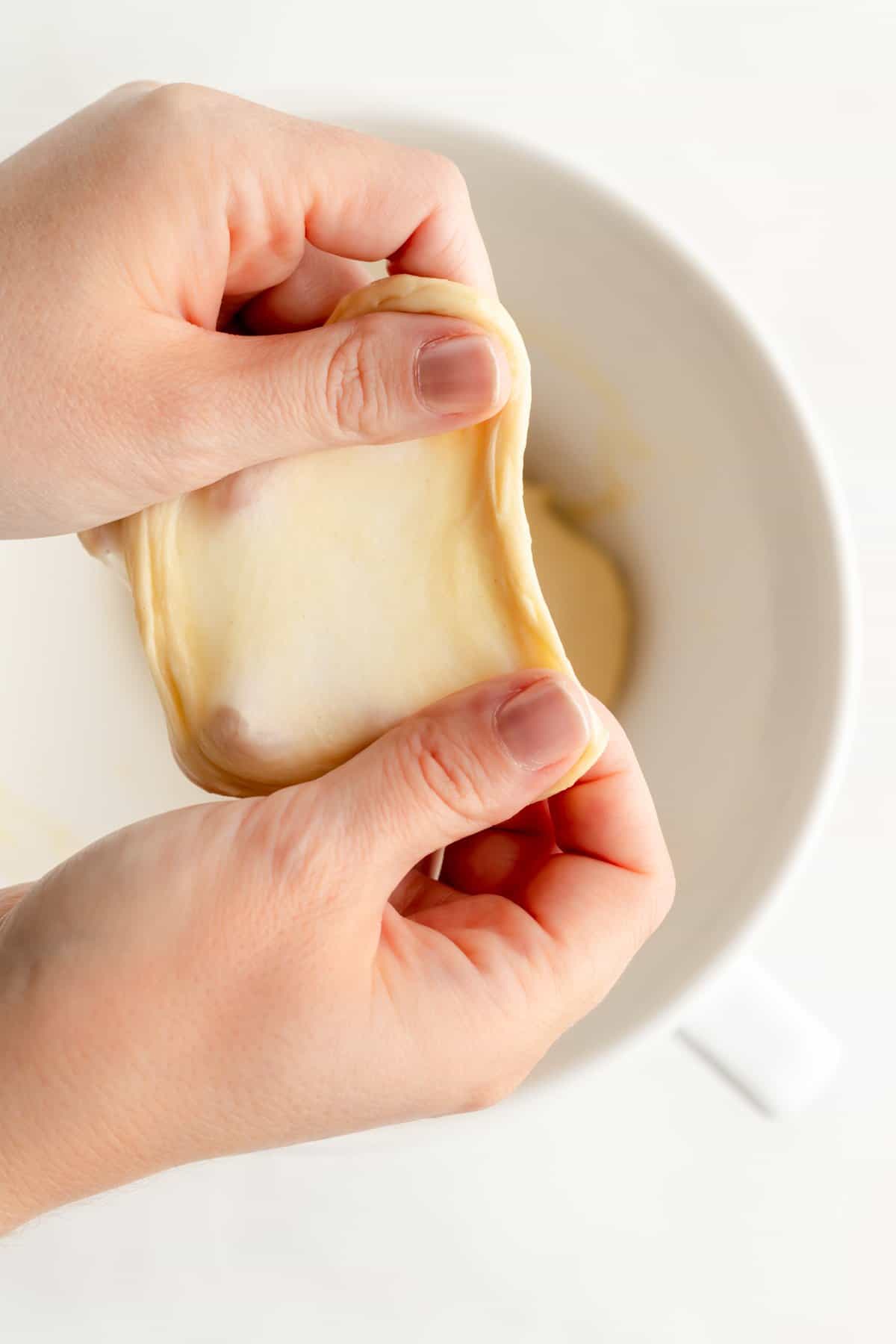
- Allow dough to rise in a warm place until doubled in size, about 1 ½ hours. You'll know it's ready when it fully holds the indent of your finger when gently pressed.



TO ASSEMBLE THE ROLLS:
- Make the cinnamon and sugar by combining them in a small bowl until well blended.

- At the end of the rise, knock the dough down to remove the gases.

- Roll it into a 12” wide by 18” long rectangle.

- Top the dough with cooled apple filling, and spread it into an even layer, leaving a clean seal edge.
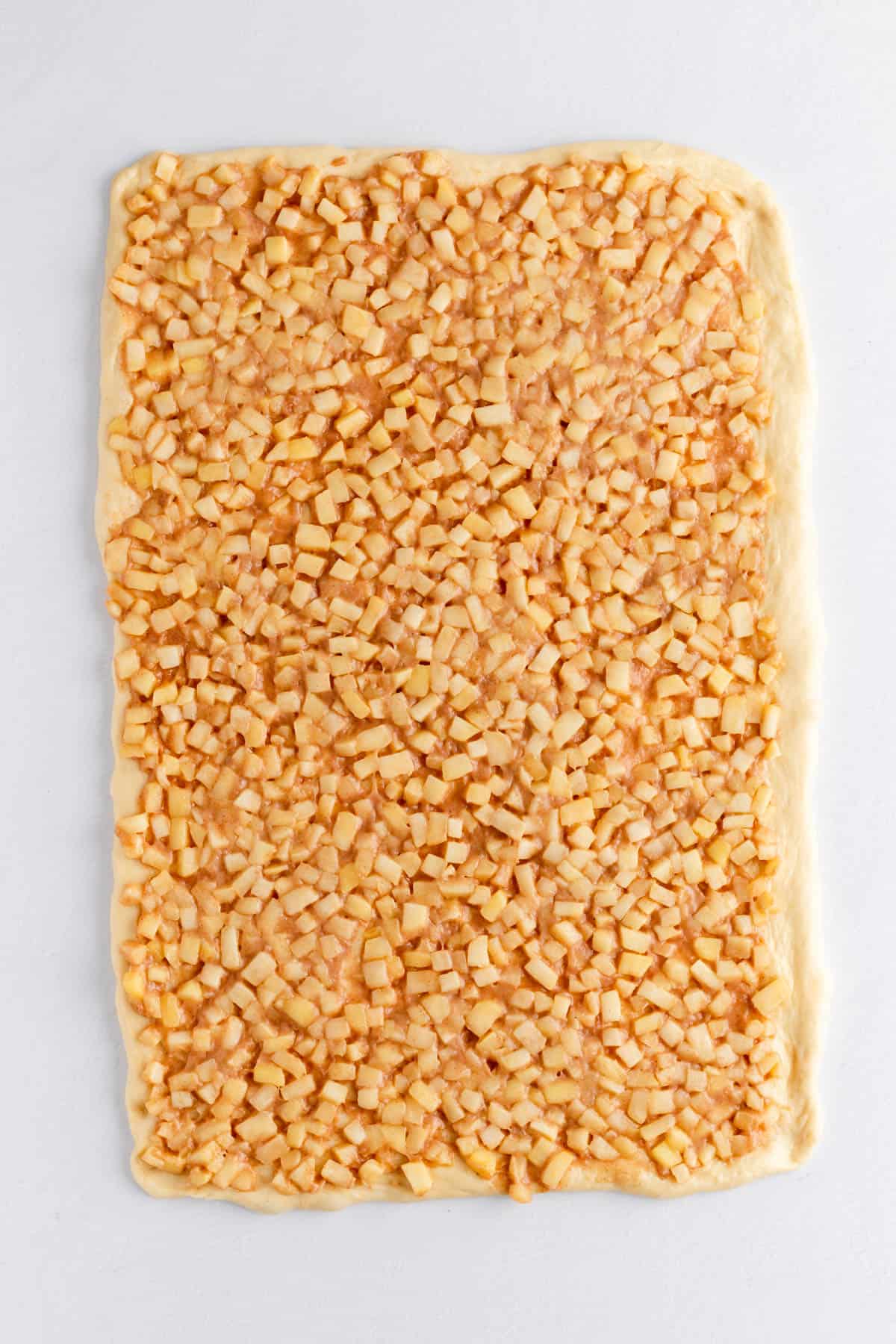
- Sprinkle cinnamon and sugar evenly over the top of the apples.

- Starting with the edge opposite of your clean seal edge, carefully roll dough in a tight log from one end to the other.

- Use your fingers to firmly pinch the seam together and seal your log up well. Using a sharp knife, and a “sawing” not “crushing” motion, gently slice off your rolls until you have 12 equal rolls, about 1.5” wide each.

- Space them out evenly in a lightly greased 9”x13" pan, arranged 3 by 4.

- Allow to rise again until they’re puffy, touching each other, and the dough again feels very soft and holds an indent when gently pressed (about an hour). Near the end of the rise time, preheat oven to 350°F.

- Bake the buns on the middle rack of the oven for 30-35 minutes until they are golden brown and fully set. Allow rolls to cool in the pan on a wire rack for 15-20 minutes while you prepare the icing.

TO MAKE THE CREAM CHEESE GLAZE:
- Mix together butter and cream cheese until smooth and fully combined.

- Mix in the powdered sugar, milk and vanilla until fully combined and smooth.

- Spread icing on warm (but not super hot) rolls, right in their pan. Then cut them up and enjoy a perfectly warm and messy apple-licious treat!

And check out the full RECIPE WEB STORY for a click-through tutorial!
Tips for Sweet Success + FAQs
Can you make these apple cinnamon rolls ahead of time?
While you can make these rolls ahead of time and serve them the next day, because they need to be held in a fridge due to all the fruit, they're really best served warm and fresh about half an hour after they come out of the oven.
How do you store leftover apple-filled cinnamon rolls?
Store these rolls wrapped airtight in the fridge for up to three days. To enjoy, simply reheat for 15 to 30 seconds in the microwave for that just-baked experience!
Can you freeze baked or unbaked cinnamon rolls?
While you can freeze these rolls baked and un-iced, I highly recommend eating them fresh as the texture and overall experience is going to be much more enjoyable.
You should not freeze these rolls unbaked as it will affect the yeast negatively, and the final rise will be seriously stunted if you were to try to bake them from the freeze.
Can I use pre-made cinnamon rolls?
This recipe isn't really adaptable to pre-made cinnamon rolls, like those you get in the pop tubes.
If you'd like to make the dough from a box mix, that is okay as long as you end up with enough dough. So just double check the yield on the box and know you may need two for this full recipe.
If using a box mix, follow their instructions for rise times.
If you really want to use those pop-tube cinnamon rolls which are delicious in their own right, I'd just check out a recipe designed for pre-made ingredients like this one.
Can I use pre-made apple pie filling?
If you'd like, you can trying using pre-made apple filling, but as all pre-made fillings are a little different and looser than this fresh one, I can't guarantee great results.
If you do decide to experiment with the pre-made fillings, here are two tips:
1) Firstly, the apples will probably be too big for cinnamon rolls, so I'd dice the apples up quite a bit.
2) I'd try to pick out mostly the apples and leave the extra sauce behind so your rolls don't get too sloppy to handle.
If you want my two cents, I totally understand that sometime the quickest version of recipe is the way to go. But in that case, I'd recommend checking out a recipe designed for pre-made ingredients like this one.
Can you substitute other fruit for the apples?
I would recommend sticking with apples or pears, or a combination of the two as they behave pretty similarly in a recipe like this. Other fruits will have very different water content and your results would be unpredictable.
Can I make these rolls overnight?
I wanted to throw in a quick note about an overnight prep option for these cinnamon rolls with apple pie filling.
Technically, you can hold these rolls overnight in the fridge, and have the first rise happen while they chill. Then, you'd continue on with the recipe as written from there in the morning.
Personally, I don't recommend this option unless you're an experienced baker, as you'll find the dough progression to be much more predictable when the dough is freshly prepped as the chilled butter really changes the dough dynamics. The final rise of the baked rolls will also be best when you make this recipe start to finish on the same day.
These rolls also reheat very well. So my recommended overnight option is to bake them off the night before and then cover them with plastic wrap in their pan overnight at room temperature, unfrosted. Then just place them back in the oven in the morning for 10-15 minutes or so at 350°F just until they're rewarmed. You can then prep the icing and frost them right before service.
This method is way more dependable than trying to delay the rise of raw dough overnight. And honestly, you really won't notice any significant difference between this method and a roll you made start to finish that morning.
Is the dough supposed to be sticky or dry?
When prepared correctly, this dough is neither sticky nor dry. It is easy to handle and roll out with just a little flour on the work surface.
At times, bread doughs in general can be extra tricky if there are additional factors such as a really dry or humid environment, or maybe a little extra water or flour got added if you weren't using a scale for measurement.
So if your dough is extra sticky after 5 minutes of kneading, you can add flour, a tablespoon at a time, as needed. If it’s really dry and won’t grab the hook at all, you can splash water on it 1-2 teaspoons at a time, as needed, just until it gets a little tackiness to it.
Just be careful not to overdo it with either addition! Give the dough at least 1 minute to incorporate each addition before adding more.
Can I use an oven for proofing my dough?
I know many recipes you'll see will recommend proofing your dough in a preheated oven or proofing drawer.
I highly caution against this unless you're experienced with bread doughs, because frankly ovens are unpredictable, especially at really low temperatures, and you can either cook your yeast or seriously over-proof your dough.
Your dough should rise perfectly fine at room temperature, around 70°F, as long as your ingredients are the right temperature when added to the dough.
If you keep your house particularly cold, you could run your shower super hot with the bathroom door closed for 5-10 minutes, and then place the dough in there (with the shower off) so that room stays nice and warm and steamy for your dough.
You'll find that using a naturally warm room will give you a much more predictable timeline and also allow the dough to develop the maximum amount of flavor.
Why didn't my rolls rise? Part 1: temperature issues.
Bread doughs are not a simple science, and frankly there could be many answers to why your rolls don't want rise. However, there are a few common culprits...
1. Your ingredients were too cold: if your ingredients are too cold going into your dough, the dough temp will not be high enough for the yeast to really thrive and puff up that dough. To prevent this, just make sure you follow the temperature tips in the ingredient list as written.
2. Your proofing room is too cold: similarly, if your space is too cold for the dough to rise, the yeast again can't thrive and really get going to give you that beautiful rise. To prevent this, just make sure you have a nice warm room, or again use the shower trick noted above if you need to create a warmer space in your home.
If you think all your temperatures were correct and still had issues with rise, check out Part 2 below.
Why didn't my rolls rise? Part 2: over-proofing issues.
The dough may actually be over-proofed (aka over-risen).
Although it may seem a little counter intuitive, a common reason why your final cinnamon rolls may not be fully risen is because they actually over-proofed before they made it to the oven.
If you leave your dough for 4 hours on the counter, or in way too warm a space (like a preheated oven) to rise, you'll find it not only rises, but it gets overly-soft and almost deflated looking (typically greasy as well in the case of brioche).
Unfortunately, there really is no going back from that. The yeast has used up all of its rising power before you enter the oven. Therefore your rolls won't get a nice extra spring from that heat as they usually would, because the yeast is essentially already tapped out.
Again, there's no way to fix this once it's happened, it's just something to be aware of so when you mix up your next batch, you know to more carefully watch your rolls and check on them a little sooner.

Other Breakfast Treats You'll Love
Craving more delicious treats? Here are a few of my other favorite breakfast treat recipes:
- Cinnamon French Toast Pancakes
- Cinnamon and Sugar Donut Muffins
- Mini Jam-Filled Strawberry Donut Muffins
- Blueberry Brioche French Toast Casserole
- Apple Hand Pie with Cinnamon Streusel
- Double Cinnamon Streusel Muffins
- Fluffy Lemon Pancakes with Fresh Lemon Whipped Cream
- Classic Buttermilk Pancakes
- Blueberry Scones with Maple Glaze
- Sour Cream Blueberry Muffins with Cinnamon Streusel

⭐ If you gave this recipe a try please give it a ⭐ rating and tag me on Instagram @mint.and.mallow.kitchen so I can see what you're baking up! ⭐
📖 Full Recipe
Apple Pie Filling Cinnamon Rolls (with cream cheese glaze!)
Ingredients
FOR THE APPLE FILLING:
- 3 tablespoons sugar
- ¼ cup all-purpose flour
- 2 teaspoons ground cinnamon
- ½ teaspoon salt
- ¼ cup (½ stick) unsalted butter
- 1 tablespoon lemon juice
- 7 cups chopped apples (6-9 apples depending on size, peeled and cut into ¼" cubes)
FOR THE DOUGH:
- 1 cup lukewarm water*1 (75-80°F)
- 2 ½ teaspoons (one 7g packet) active dry yeast*2
- 2 large eggs*3 (room temperature)
- 4 ½ cups all-purpose flour
- ¼ cup sugar
- ¾ teaspoon salt
- ¾ cup (1 ½ sticks) unsalted butter (very softened, cut into tablespoon chunks)
FOR THE CINNAMON + SUGAR:
- ¼ cup sugar
- 2 teaspoons ground cinnamon
FOR THE GLAZE:
- 2 tablespoons (¼ stick) unsalted butter (softened)
- ¼ cup (2 ounces; ¼ brick) Philadelphia Original Cream Cheese (softened)
- 1 ⅓ cups powdered sugar (sifted)
- 2 tablespoons milk, half and half, or cream
- ½ teaspoon vanilla extract
Instructions
TO MAKE THE FILLING:
- Mix dries: stir together the sugar, flour, cinnamon and salt for the apple filling in a small bowl.
- Melt butter: melt ¼ cup butter in a medium-sized non-stick pan over medium heat.
- Cook apples until tender: add the dry mixture, lemon juice, and apples to the melted butter and stir until combined. Continue to cook on medium-low until apples start to soften, about 12-14 minutes, stirring frequently to prevent burning. When ready, the apples will have released some of their juices, which will have formed a thick, tacky caramel.
- Cool while preparing the dough: once softened, transfer apples to a bowl and place in the freezer for at least 45 minutes (ideally an hour+) to cool before assembling your rolls. To help the filling cool evenly, stir the apples briefly about every 15 minutes until the mixture is room temperature or a little cooler. Once cooled, simply leave the filling on the counter until it’s time to assemble the rolls.*4
TO MAKE THE DOUGH:
- Combine yeast and water: stir together yeast and lukewarm water in the bottom of stand mixer’s bowl (a hand mixer won’t work for this dough).*5 Allow to sit for 5 minutes while you measure out remaining ingredients (this helps the yeast start to activate and dissolve).
- Stir in eggs: after the 5 minutes is up, add the eggs to your bowl and blend with the water/yeast mixture.
- Add dries and butter, then mix on low to combine: add dry ingredients and soft butter cut into tablespoons into your mixer bowl. Using a dough hook, run mixer on the lowest setting (usually “stir”) until all ingredients are roughly combined, scraping bowl as needed to help any dry pockets blend in (about 1-2 minutes).*6
- “Knead” on medium-low speed until elastic: with mixer on 2/10, allow the dough to mix for 2 minutes so it can start forming into a single, sticky mass. After that, raise the speed to 3 or 4/10 (no higher than 4/10)*7 and allow dough to mix for 8-10 minutes, checking it often. You’ll know it’s ready when it has formed into a single smooth mass, and it springs back with a little elasticity when you pull on it. When ready, you should be able to stretch it into a thin “window pane” (see photos in post for more detail!).*8
- Allow dough to rise: remove dough from mixing bowl and form loosely into a ball. Lightly grease mixing bowl with baking spray, then drop dough back into bowl, rolling it around to lightly grease it on all sides (this prevents a skin from forming). Loosely cover bowl with a dish towel or plastic wrap (that’s not sealed), and allow dough to rise in a warm place for about 1 ½ hours until doubled in size, soft, and very puffy. When it’s ready, an indent should remain with no bounce back when you press your finger gently into the dough (see photos in post for more detail!).
TO ASSEMBLE THE ROLLS:
- Make cinnamon + sugar: stir the 2 tsp cinnamon and ¼ cup sugar together in a small bowl and set aside.
- Knock it down and roll it out: working on a lightly floured surface, dump your risen dough out onto your surface, then press it down with your hands to deflate it and release the gases. Re-flour your surface as needed and roll dough into a 12” wide by 18” long rectangle.
- Add filling: spread cool apple filling evenly over the surface of your dough, but leave a ½” border along one long edge to use as a seal. Then, sprinkle cinnamon and sugar evenly overtop the apple filling, again avoiding the clean seal edge.
- Roll it up: starting with the long edge opposite of your clean seal edge, carefully roll dough in a tight log from one end to the other (do your best to keep your roll tight, but know the dough will be very soft, so don’t worry if the roll isn’t perfect). Once your roll reaches the clean edge, use your fingers to firmly pinch the seam together and seal your log up well.
- Slice off the rolls: using a sharp knife, and a “sawing” not “crushing” motion, gently slice off your rolls until you have 12 equal rolls, about 1.5” wide each.
- Pan them up: space them out evenly in a lightly greased 9”x13” pan, arranged 3 by 4. (Don’t worry if the rolls aren’t touching - they’ll expand during both the rise and bake.)
- Allow to rise again: place a lightly greased piece of plastic wrap loosely over your pan, not touching the rolls if possible, and allow the dough to rise about an hour in a warm place until the rolls are puffy, touching each other, and the dough again feels very soft and holds an indent when gently pressed. Near the end of the rise time, preheat oven to 350°F.
- Bake ‘em: remove the plastic wrap and bake the buns on the middle rack of the oven for 30-35 minutes until they are a light golden brown.
- Cool ‘em off a bit: once rolls are baked, allow them to cool in the pan on a wire rack for about 30 minutes while you prepare the icing.
TO MAKE THE GLAZE:
- Combine butter and cream cheese: place softened butter and cream cheese in a medium-sized bowl. Mix together until smooth and fully combined by hand or with a hand mixer on low.
- Mix in remaining ingredients: add in the powdered sugar, milk, and vanilla extract, and blend until fully combined and smooth. The glaze should be fairly thick, but still just barely pourable.
- Spread, slice and enjoy! Spread icing on warm (but not super hot) rolls, right in their pan. Then tear off a gooey apple roll and enjoy a perfectly warm and messy sweet mash-up!
Test Kitchen Tips
- *1Lukewarm water: the best way to ensure the right temp of water is to use an instant-read thermometer (we’re going for 75-80°F in this recipe), but if you don’t have one available, simply use your best judgement to feel when the water is “lukewarm” but not “hot.” If the water is too hot or too cold, it will negatively effect the yeast and your rise.
- *2Active dry yeast, not instant/rapid! For this recipe we want to use “active dry” yeast, bulk red yeast or bulk gold yeast, because they're all designed for the 2-rise process we’re using here. Rapid/Instant yeast is only designed to rise once, and likely will lead to a less risen, and less flavorful roll.
- *3Room temperature egg hack: if you need to get your egg to room temp in a hurry, simply submerge it whole in a large container of warm water for 10-15 minutes until it’s warmed up and ready to go.
- *4Filling temperature matters: we need the filling to be not too hot and not to cold when we go to assemble our rolls. If the filling is too hot, it'll melt the butter in your dough and your rolls will be difficult to handle and struggle to rise properly. If it’s too cold, it will have similar effect for different reasons. So aim for room temperature or a little cooler.
- *5Not up for making the dough from scratch? If you’d really love to try this recipe, but homemade brioche dough is just a bit too intimidating, you can use this Hot Roll Mix as a relatively quick and easier alternative. If you’d like to use a refrigerated or frozen dough, you’re welcome to experiment, but I personally can’t recommend those here as they’ll vary greatly in flavor and performance, so I find it safer to stick with a scratch-based, predictable dough.
- *6Kneading Options: I highly recommend using a stand mixer for this recipe as brioche is both very messy and rather difficult to make by hand unless you’re an experienced bread maker. But if you’d like to try it by hand, know you may need to knead the dough for 20+ minutes to reach full development. Alternatively, you can knead this dough in a bread machine. To make in a bread machine, “bloom” yeast by completing the first step, then add all remaining dough ingredients, including butter, to the mixing bin and run it on the “dough” cycle (not the bake). Once the dough cycle is complete, continue on with the recipe from assembly step 1.
- *7Keep the mixer at 4/10 at the most! Don’t turn the mixer up past 4 or walk away from your dough for very long because it can over-mix very easily and there’s no going back from that unfortunately.
- *8Sticky or Stiff Dough: if dough is extra sticky after 5 minutes of kneading, you can add flour, a tablespoon at a time, as needed. If it’s really dry and won’t grab the hook at all, you can splash water on it 1-2 teaspoons at a time, as needed, just until it gets a little tackiness to it. Just be careful not to overdo it with either addition and allow each addition to fully incorporate before adding another!
- Storage: be sure to store these rolls in the fridge due to all their fruit, and feel free to reheat a roll in the microwave for about 30 second before enjoying. They will keep stored air-tight for 3-4 days in the fridge.



















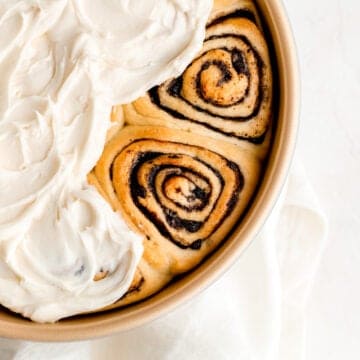
Comments
No Comments